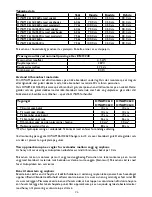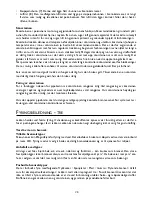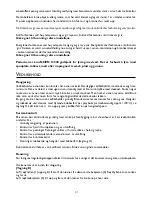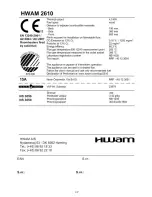
36
Vertical cross-section of smoke flue (Drawing B and C)
B: Top smoke outlet C: Rear smoke outlet
• Steel chimney (9).
• Flue gas elbow (10). Fits into smoke flue socket.
• Brick-built jamb of flue (11).
• Built-in pipe sleeve (12). Fits smoke flue.
• Wall rosette (13). Covers disruption to wall around pipe sleeve.
• Joint (14). Sealed with packing material.
• Smoke outlets (15) of the HWAM stove.
• Smoke flue regulating damper (16).
• Soot door (17).
Fitting the loose parts
Before the stove is installed, you must ensure that all loose parts are fitted correctly.
Vertical cross-section of the stoves (Drawing B):
• The smoke shelf (5): Should rest on the rear plate and on the stand uppermost in the front of the
combustion chamber.
• The baffle plate (6): Is suspended on two hooks, one in either side uppermost in the combustion chamber.
To mount the baffle plate, lift it to a position at the very top of the combustion chamber, and then push
it back until it falls into place in the two hooks. When the stove is installed, the transport protection is
removed. Lift the smoke shelf up and forward. Then lower it and remove it from the combustion chamber.
Subsequently, the transport protection is bent downwards/forwards until it is vertical.
• The cast iron bottom plate (7): Must be in a flat position at the bottom of the combustion chamber.
• Air grate (8). Place the accompanying air grate on the cast-iron bottom of the combustion chamber, as
far up front as possible and with the slats pointing backwards. The grate is positioned correctly when
grate and bottom slot together.
Chimney
The chimney is the “engine” of the stove and it is crucial for the functioning of the woodburning stove.
The chimney draft provides a partial vacuum in the stove. This vacuum removes the smoke from the stove,
sucks air through the dampers for the so-called glass pane rinse which keeps the glass free of soot, and
sucks in air through both primary and secondary dampers for the combustion.
The chimney draft is created by the differences in temperature inside and outside the chimney. The higher
the temperature within the chimney, the greater the draft. It is crucial, therefore, that the chimney is warmed
up properly before closing the damper and limiting the combustion in the stove (a brick chimney takes
longer to warm up than a steel chimney). On days where the weather and wind conditions create insufficient
draught inside the chimney, it is even more important to warm up the chimney as quickly as possible. The
trick is to quickly get some flames going. Split the wood into extra fine pieces, use an extra firelighter, etc.
If the stove has not been used for a longer period, it is important to check that the chimney pipe is not
blocked.
It is possible to connect several devices to the same chimney. However, it is important to first check the
applicable rules.
Even a good chimney can function badly if it is not used correctly. Similarly, a bad chimney may function
well if used correctly.
Chimney sweeping
To prevent the risk of chimney fires, the chimney must be cleaned every year. The flue duct and the smoke
chamber above the baffle plate must be cleaned together with the chimney. If the chimney is too tall to
be cleaned from above, it must be equipped with a soot door.
In case of a chimney fire, close all dampers and call the firefighters. Before any further use, have the
chimney checked by the chimney sweeper.
Summary of Contents for 2610
Page 2: ...2 ...
Page 4: ...4 B C A 3 1 1 4 45 4 3 2 1 11 12 14 14 15 9 11 10 17 14 12 13 1 4 6 5 15 7 8 16 ...
Page 5: ...5 E F D 1 1 2 3 ...
Page 6: ...6 G ...
Page 7: ...7 H ...
Page 42: ...42 ...
Page 43: ...43 ...
Page 44: ...44 ...
Page 45: ...45 ...
Page 46: ......
Page 47: ......













































